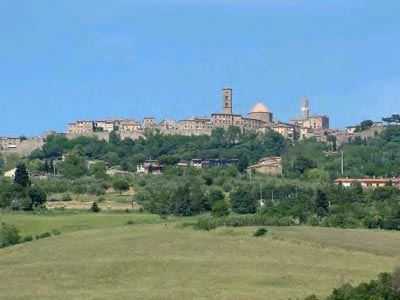
A man named Enea Silvio Piccolomini was born in 1405 in the obscure town of Corsignano in the Tuscan countryside near Siena. The town was named for the
castello known to have existed there since the 9th century. Piccolomini received a good education and became a knowledgeable man, a poet and humanist, and he began to travel. He is remembered now by another name,
Pope Pius II, and he gave back to his little hometown in a big way, so much so that his papal moniker was incorporated into the town's new name,
Pienza. His autobiography,
Commentaries (
sections in Latin, online), was long mistaken as the work of its scribe, Gobelinus. I read an interesting article by Roderick Conway Morris (
A pope with an aesthetic legacy, August 14) in the
International Herald Tribune, which might interest some of you:
But Pius also bequeathed to posterity a more public monument to himself, one grander, more eccentric, more richly emblematic than any other papal memorial. He transformed his remote home village of Corsignano, a hilltop hamlet amid the rolling countryside south of Siena, into a miniature ideal Renaissance city, renaming it Pienza ("Piusville") in honor of the title he took as pontiff. Pius was born in 1405, and in slightly tardy celebration of this 600th anniversary, Palazzo Piccolomini in Pienza is playing host to a fascinating exhibition: "Pius II: The City and the Arts." There is also a parallel show in Siena, "The Rebirth of Sculpture" at Santa Maria della Scala, devoted to the resurgence of this art form during and after Pius's reign. Both shows continue until Oct. 8. [...]
At home, he set about advancing Piccolomini family interests and consolidating them by creating a new fiefdom centered on his home village. He elevated this out-of-the-way place to the status of a bishopric and redrew local boundaries to make it the administrative heart of a much larger territory. But most ambitious of all was his scheme to rebuild the place according to the classical revivalist ideas of Leon Battista Alberti. The core of the project involved laying out a new piazza, flanked by a cathedral, family palazzo, bishop's residence and city hall. Bernardo Rossellino was chief architect, but Pius was a constant participant, defining what he wanted, sometimes in the most minute detail. The main components were finished in the astonishingly short time of five years. Encouraged by these major works, other individuals set about rebuilding and expanding the rest of the fabric of the city.
Palazzo Piccolomini was exceptionally luminous and comfortable, with a sophisticated system for gathering, filtering and distributing water; winter and summer rooms; concealed servants' staircases; and kitchens on every floor. The spacious loggias of the Palazzo Piccolomini, facing the countryside to the south and the distant Mount Amiata, looked out over the first "hanging garden" to be laid out since antiquity. Pius's visionary blending of architecture and the surrounding countryside into a seamless whole speaks volumes about his unusual and historically precocious appreciation of nature and landscape (a passion that runs like a leitmotiv throughout his writings).
Read the rest of the article for more information about the rest of this remarkable little town. I went there years ago, the last time I went to Siena and Montepulciano.
 A man named Enea Silvio Piccolomini was born in 1405 in the obscure town of Corsignano in the Tuscan countryside near Siena. The town was named for the castello known to have existed there since the 9th century. Piccolomini received a good education and became a knowledgeable man, a poet and humanist, and he began to travel. He is remembered now by another name, Pope Pius II, and he gave back to his little hometown in a big way, so much so that his papal moniker was incorporated into the town's new name, Pienza. His autobiography, Commentaries (sections in Latin, online), was long mistaken as the work of its scribe, Gobelinus. I read an interesting article by Roderick Conway Morris (A pope with an aesthetic legacy, August 14) in the International Herald Tribune, which might interest some of you:
A man named Enea Silvio Piccolomini was born in 1405 in the obscure town of Corsignano in the Tuscan countryside near Siena. The town was named for the castello known to have existed there since the 9th century. Piccolomini received a good education and became a knowledgeable man, a poet and humanist, and he began to travel. He is remembered now by another name, Pope Pius II, and he gave back to his little hometown in a big way, so much so that his papal moniker was incorporated into the town's new name, Pienza. His autobiography, Commentaries (sections in Latin, online), was long mistaken as the work of its scribe, Gobelinus. I read an interesting article by Roderick Conway Morris (A pope with an aesthetic legacy, August 14) in the International Herald Tribune, which might interest some of you:
Even if this don't change it so much, I have to say the photo don't portrait Pienza.
ReplyDeleteSee http://www.pienza.com/ and many photos on http://www.flickr.com
Regards
MazE